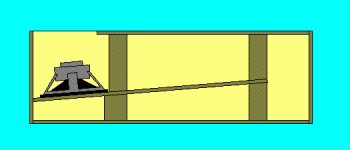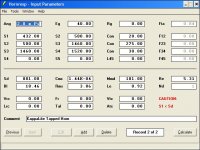wizard = awesome David ! - you've beat Akabak - this is one powerful "little" program - many thanks for all the versions. (may I ask -do you have a horn system?)
how does one interpret narrow group delay spikes in tapped horn predictions? - here's a 3M variant of William's 30Hz
Freddy
how does one interpret narrow group delay spikes in tapped horn predictions? - here's a 3M variant of William's 30Hz
Freddy
An externally hosted image should be here but it was not working when we last tested it.
freddi said:wizard = awesome David ! - you've beat Akabak - this is one powerful "little" program - many thanks for all the versions. (may I ask -do you have a horn system?)
how does one interpret narrow group delay spikes in tapped horn predictions? - here's a 3M variant of William's 30Hz
Freddy
Hi Freddy,
< many thanks for all the versions >
You're welcome 🙂
< do you have a horn system? >
Not at the moment. I did have a replica Klipschorn system many years ago - the original version of Hornresp was written to analyse the design before I constructed it 🙂.
< how does one interpret narrow group delay spikes in tapped horn predictions? >
The narrow group delay spikes are due to rapid changes in phase - see the associated phase response chart. I doubt that they would have much significance subjectively. Someone with more practical experience in such matters would be better qualified to comment though.
Kind regards,
David
thanks David - is there a means to lean a divider back so there's a downwards flare taper as in a Karlson wedge? - -oddball situation but might approximate something..
Freddy
Freddy
A big thank-you from me as well David. I know everyone appreciates the effort you've put into your software, and your willingness to write / add new features.
Best
Scott
Best
Scott
freddi said:how does one interpret narrow group delay spikes in tapped horn predictions?
Hi Freddy,
Just to add to my earlier reply. As mentioned previously, the spikes in group delay are caused by rapid changes in phase. What I failed to point out was that the most abrupt changes shown in the phase response chart are due to phase-wrapping which is inherent in the mathematics used to calculate phase. The instantaneous phase swings seen in the phase response chart and picked up in the group delay calculations do not actually occur in practice. This means that the most severe spikes on the group delay chart should be disregarded when considering tapped horns.
Hope this helps to clarify things a bit 🙂.
Kind regards,
David
freddi said:is there a means to lean a divider back so there's a downwards flare taper as in a Karlson wedge? - -oddball situation but might approximate something..
Hi Freddy,
There are no theoretical limitations on directly analysing negative flare conical horns, and negative flare horns of other types can be solved for indirectly using a number of conical elements to approximate the horn profile. The functionality is currently not available in Hornresp though, as it really only works correctly for plane wavefront models. I also assumed that it would have little practical application 🙂.
Kind regards,
David
Scottmoose said:A big thank-you from me as well David. I know everyone appreciates the effort you've put into your software, and your willingness to write / add new features.
Best
Scott
Hi Scott,
No problems, pleased to be able to help out. Thanks for the thanks 🙂.
Kind regards,
David
Hi David - thanks for comments - FWIW one can fudge Karlson response up to cavity peak as a coupled cavity type using 3rd Z peak (vented case) as estimate of front chamber tuniing.
is there a way to trick Hornresp into analyzing the case of woofer mounted in mouth of a stubby horn vent reflex?
Best wishes,
Freddy
is there a way to trick Hornresp into analyzing the case of woofer mounted in mouth of a stubby horn vent reflex?
Best wishes,
Freddy
freddi said:is there a way to trick Hornresp into analyzing the case of woofer mounted in mouth of a stubby horn vent reflex?
Hi Freddy,
Not that I am aware of, unfortunately.
Kind regards,
David
Hi David,
Thanks for your great work! I have a small question which is not only for the tapped horn, so please forgive me, if I post it here.
If you analyze a group of horn boxes, you use them many times in groups giving bigger horns and even bigger front surface, where the front surface is biiger than the horn.
I would like to see the gain coused by the directivity behavior included in the SPL response as an option. Furthermore if you use horns wich are built in into a bigger surface (like the moost tapped horns or as a special case the BDEAPs) it would be nice to have a parameter for the height and the width of the front surface of the boxes...
Also the reflexions from the edges changes the frequency response mainly in ht eHF and MF range...
Thanks,
Tamas Tako
Thanks for your great work! I have a small question which is not only for the tapped horn, so please forgive me, if I post it here.
If you analyze a group of horn boxes, you use them many times in groups giving bigger horns and even bigger front surface, where the front surface is biiger than the horn.
I would like to see the gain coused by the directivity behavior included in the SPL response as an option. Furthermore if you use horns wich are built in into a bigger surface (like the moost tapped horns or as a special case the BDEAPs) it would be nice to have a parameter for the height and the width of the front surface of the boxes...
Also the reflexions from the edges changes the frequency response mainly in ht eHF and MF range...
Thanks,
Tamas Tako
Hy Tako,
this would be great, indeed. But it´s not a simple task, since boundary effects and reflections, Baffle.Step, room gain etc. have to be implemented to get accurat results, not to mention a good knowledge on how these work for the user in order to get good results. As far as I understand your request, being able to choose between half-space, quarter-space, free space, etc.. doesn´t surfice your needs, right? (Since this already is possible)
Being able to do so in hornresp would pimp this "little diamond" to an even more awesome tool...
In the meantime, try Akabak for this, it ist able to simulate almost every environment and takes Box-sizes into account.
this would be great, indeed. But it´s not a simple task, since boundary effects and reflections, Baffle.Step, room gain etc. have to be implemented to get accurat results, not to mention a good knowledge on how these work for the user in order to get good results. As far as I understand your request, being able to choose between half-space, quarter-space, free space, etc.. doesn´t surfice your needs, right? (Since this already is possible)
Being able to do so in hornresp would pimp this "little diamond" to an even more awesome tool...
In the meantime, try Akabak for this, it ist able to simulate almost every environment and takes Box-sizes into account.
Hi,
Yes I have AkAbak since 2 years, but I wasn't able to model the directivity coused Gain. I have measurements from BDEAP and I wasn't able to model its directivity behavior...
It should affect the response of tapped horns stacked in groups becouse they have a relatively big front surface...
Thanks,
Tamas
Yes I have AkAbak since 2 years, but I wasn't able to model the directivity coused Gain. I have measurements from BDEAP and I wasn't able to model its directivity behavior...
It should affect the response of tapped horns stacked in groups becouse they have a relatively big front surface...
Thanks,
Tamas
I noticed that the responses that have been achieved on this thread are very good, but I still wonder if there is something we have not figured out yet, since the real DTS-20 has a better response. It goes slightly deeper, and extends further. Can anybody account for the difference?
G'day Chris8sirhC
It comes pretty close in my models when I use an exponential horn that would be folded twice in a box the size of a DTS-20(path goes down from the driver then heads back up and down again). A driver with a ~30Hz Fs and other specs similar to the LAB12 helps too. A suitable driver is not too easy to find, in practice. The Peerless XLS and XXLS drivers I've been playing with are not optimal in this regard. I'm fairly confident the DTS20 driver is very similar to a LAB12 with a stiffer spider and/or less Mms.
Cheers
William Cowan
It comes pretty close in my models when I use an exponential horn that would be folded twice in a box the size of a DTS-20(path goes down from the driver then heads back up and down again). A driver with a ~30Hz Fs and other specs similar to the LAB12 helps too. A suitable driver is not too easy to find, in practice. The Peerless XLS and XXLS drivers I've been playing with are not optimal in this regard. I'm fairly confident the DTS20 driver is very similar to a LAB12 with a stiffer spider and/or less Mms.
Cheers
William Cowan
ttako said:I would like to see the gain coused by the directivity behavior included in the SPL response as an option. Furthermore if you use horns wich are built in into a bigger surface (like the moost tapped horns or as a special case the BDEAPs) it would be nice to have a parameter for the height and the width of the front surface of the boxes...
Also the reflexions from the edges changes the frequency response mainly in ht eHF and MF range...
Hi Tamas,
Nice to hear from you again, it's been quite a while 🙂.
As Sabbelbacke points out, taking the directivity effects of a multiple speaker array into account (accurately) as part of calculating the overall SPL is not such an easy thing to do. In all honesty, I think that I would probably be just wasting my time trying to make Hornresp operate at that level of sophistication - there are simply too many variables involved 🙂.
Kind regards,
David
No.
You need to run at least a 1X3 (on edge) the full length of all the long panels in addition to your tiny cross braces.
You need to run at least a 1X3 (on edge) the full length of all the long panels in addition to your tiny cross braces.
Hi DJK, I suspect that you're right, but those two braces do add stiffness to two of the three worst areas (the free edge of the flare and the right edge of the mouth). I think that the left edge of the mouth requires some bracing, and the large, unsupported areas need help.
Hi Freddi, here is the hornresp input:
Hi Freddi, here is the hornresp input:
Attachments
- Home
- Loudspeakers
- Subwoofers
- Collaborative Tapped horn project

